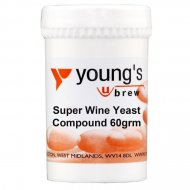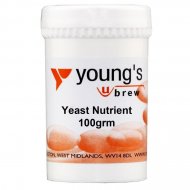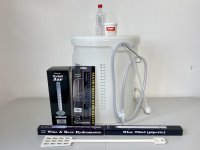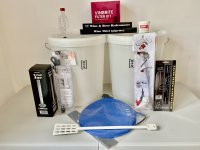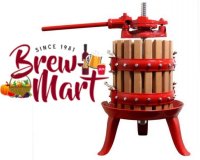Grape Wine
Many people who have a vine, or a few vines, are puzzled as to how to convert the grapes into wine, but in essentials, nothing could be simpler.
First, ensure that your grapes are as ripe as possible (the bird will let you know when they are nearly ready, if the vine is unprotected). Gather them, and set to work quickly. All you have to do is to ferment the grape juice, but it is well to note that, if making small quantities, with a consequent high degree of wastage, as much as between six and 7 kg of grapes will be required to produce 4.5 L (1 gallon of wine. About 2 kilograms will make one bottle. And, even in one of our sunniest summers, when the sugar content of our grapes will be higher than usual, you must expect to have to add some brewing sugar if a reasonably strong wine is required.
If you use a hydrometer, it is simple to determine the amount. However, if you do not, the goal is to aim for a strong wine, typically containing 12 to 14% alcohol by volume. Continue adding sugar in small quantities, such as 100 grams to 4.5 Litres at a time, until fermentation reaches its maximum potential and the sweetness of the wine meets your taste.
Many beginners seem to be puzzled by the difference between white wine and red, and ask whether black grapes can be employed to produce the former.
The answer is yes. White wine can be made from grapes of either colour (although it should be noted that there are some black grapes, such as Baco No. 1, which yield red juice); the method is to express the juice and ferment it alone. Red juice, on the other hand, is produced by leaving the skins of the crushed black grapes in the must, so that the colour from them is extracted.
If the skins are left in for only one or two days, a vin rosé will be produced; if left for longer, a wine of much deeper colour. This process can usually be continued for about 10 days, but it is advisable not to leave it much longer; the liquid should then be drawn off.
A fruit press, of course, is advisable, and essential if making large quantities of white wine, but most wine makers will be able to contrive to press enough grapes for one or 2 gallons without one, by crushing with the hands or a piece of hardwood, or by using boards and weights, or some similar device. For white wine, of course, the grapes must be contained in Stout calico or some such material to keep the skins separate.
Aim for a strength of 12 to 14% alcohol by volume. If using a hydrometer, express the juice from a few grapes and measure the specific gravity (SG). With English grapes, it is likely to be fairly low, around 50 or 60. To obtain the desired strength, you will need to add 15 to 20 ounces of sugar. It may be higher; if so, consult the following table, given by E. Chagrin.
If you do not have a hydrometer, make a mental note that you may need to add up to 1 kg of sugar to each 1 gallon, but do so in stages. Add 250 g initially and then 100 g at a time.
If you are making wine from grapes for the first time, it is unlikely that you will want to worry excessively about acidity, as the grapes are likely to be ripe. Any slight over-acidity can be masked by a little extra sugar once the wine is made. However, for the perfectionist, grapes, and indeed English grapes, are likely to be too acidic and contain about 1.3% acid, whereas the desirable acidity is about 0.75%. The experienced wine maker will go to the trouble of correcting this by diluting with water or syrup, but for the present purpose, this is an unnecessary complication. In practice with Bacon No.1 grapes, it is invariably necessary to add as much as a quarter of the volume of grape juice in water to obtain a reasonable acidity. Do this before taking the hydrometer reading. Aim for the acidity of a good cooking Apple.
This is usually the case with red grapes, which are more difficult to ripen and therefore achieve a reasonably low acidity. In practice, after diluting to achieve the correct acidity, the goal is to restore the vinosity by adding some red grape concentrate, typically at a rate of 150 to 200 millilitres per 5 L. This restores the strength of the flavour and improves the relatively poor flavour of Baco No. 1 grapes.
The SG is then adjusted, and sugar is added as necessary to achieve a reading of 1085 to 1090, which produces a dry red wine.
The white grapes are usually much riper and require minimal acid adjustment, although some clarification, such as sugar addition, is generally necessary.
You can address the issue of acidity both during the preparation of the must and by adjusting the finished clear wine in the 1-gallon jar just before bottling. Generally, it is necessary to use either an acid-reducing solution if the over-acidity is slight or to add more water until it reaches the correct level. Adding one or two drops of Sweetez, a tablet or teaspoon of Aspartame, or another form of non-fermenting sweetener per bottle produces a highly acceptable result with this particular white grape, the Seyval. However, regardless of the variety, it is always worth experimenting with the finished wine to elevate it to the highest standard. The same is true, of course, for all other country wines. Never be content to drink a substandard wine just because that's how it turned out; if minor adjustments to strength, sweetness, acid, or even flavour can lead to an improvement, make those changes. Always experiment with a small measured sample so you can calculate the dosages needed for the whole batch.
Approximate number of ounces to be added to 1 gallon to increase the alcohol by volume to:
|
SG of grape juice |
10% |
14% |
!8% |
|
1050 |
11 |
20 |
32 |
|
1055 |
9 |
17 |
29 |
|
1060 |
7 |
15 |
27 |
|
1065 |
5 |
13 |
25 |
|
1070 |
3 |
11 |
23 |
|
1075 |
- |
10 |
21 |
|
1080 |
- |
8 |
20 |
|
1085 |
- |
6 |
18 |
|
1090 |
- |
4 |
16 |
|
1095 |
- |
2 |
14 |
|
1100 |
- |
- |
12 |
|
1105 |
- |
- |
10 |
|
1110 |
- |
- |
8 |
|
1115 |
- |
- |
6 |
|
1120 |
- |
- |
4 |
|
1125 |
- |
- |
2 |
|
1130 |
- |
- |
- |













